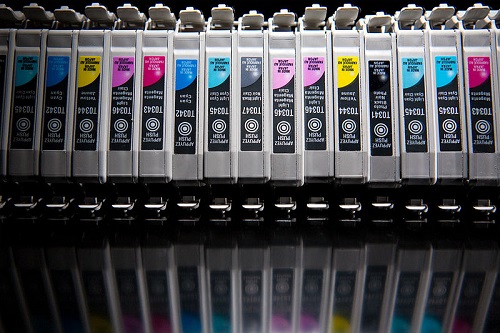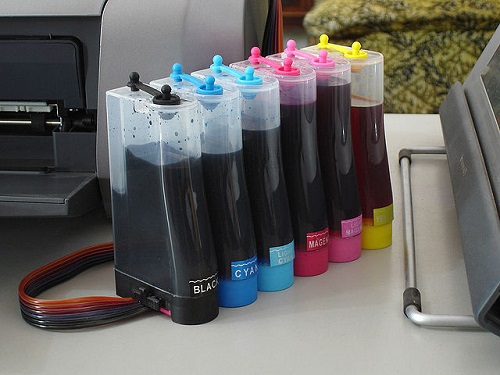
At 1ink.com, we understand that it can be frustrating to print a crucial item only to find that the ink cartridges that you bought a while back no longer work. Not only is this inconvenient when you have something important to accomplish in a limited amount of time, but with the high cost of ink and toner, it’s also a serious waste of your hard-earned money.
Read on to learn how to store ink cartridges when not in use to significantly lengthen your ink’s natural lifespan.
Protecting Your Printer
When you know exactly how to store ink cartridges when not in use, you will dramatically increase how long the ink lasts, and you may possibly be saving yourself from long term damage done to your printer. The dust particles and ink spillage that may occur due to an improperly stored ink cartridge can destroy your equipment if used. You don’t want to deal with the unnecessary expense of a malfunctioning printer on top of replacing your expired ink cartridges.
Sometimes, it is even suggested that any ink cartridge with its tape or caps removed should be immediately installed into your printer. This is terrible advice. Just imagine: if you’re not using your printer everyday, or frequently, a neglected cartridge left inside could spill and wreak havoc with your machine.
Manufacturer Guidelines
While larger printer and ink cartridge manufacturers such as Lexmark and Dell highly recommend that cartridges remain sealed in their original packages until they are ready to be used, this is not always possible.
Learning how to store ink cartridges when not in use protects your ink when you can’t follow manufacturer guidelines, and ensures that even unsealed ink cartridges are unaffected by long term care and storage. If you know how to store printer ink, your cartridges will last for quite a long time.

Always Store Cartridges Upright
Whether your cartridges are loose or still in their boxes, it is crucial that you keep them stored standing in an upright position at all times. Several secondhand cartridge manufacturers have pointed out that this is how to properly store printer ink. Many prominent printer and ink manufacturers like Epson and HP recommend storing ink cartridges label up as well. This is due to the fact that downward facing printheads can leak, and the ink in multi-colored cartridges could possibly mix, rendering them useless.
Look for a Cool, Dry Place
Ink cartridges should always be stored in a ventilated and cool area. When learning how to store ink cartridges when not in use, it is also very important that you ensure that your cartridges are never exposed to any temperatures above the average room temperature, as heat can cause bubbling and foaming in the liquid. The heated ink’s expansion and subsequent contraction when cooled can cause damage to the ink cartridge over time and may lead to future leaks during use.
Keep Cartridges in Sealed Bags
Keeping ink cartridges sealed and away from dehydrating air and heat can keep them in their original state and free from the elements and the damage they can cause. This also ensures that the print head remains moist, and that no air escapes or becomes trapped in the cartridge, affecting other adjacent parts.
Since moisture control is key when learning how to store ink cartridges when not in use, you can place any cartridges still in their original packaging in a plastic sealable bag. Importantly, ensure that it is sealed by fastening it with an elastic band.
Keep Cartridges Stored in the Dark
Direct sunlight and some artificial light sources have been known to degrade the quality of ink in stored cartridges. If you keep your ink cartridges in dark or dimly lit conditions, it is actually highly likely that those that are already opened can be successfully stored for up to six months.
However, ink cartridges that remain in their sealed packaging can last up to two years, depending on other factors in how you store printer ink.

Storing Opened Ink Cartridges
If your ink cartridges are already outside their original packaging, they should be placed in a plastic tub with an airtight lid for safekeeping. Along with the cartridges, place a damp cloth or paper in the sealed tub to initiate humid conditions in a controlled environment.
Remember, if cartridge nozzles are not stored in airtight and humidified conditions they can crust over or dry out, nullifying their usefulness. Make sure that there is nothing touching or leaning against the cartridge nozzles. If anything rubs against them, it can cause the ink to wick.
Check If Your Ink Is Usable
Part of learning how to store ink cartridges when not in use is learning how to make sure it’s still safe to use after long term storage. Sometimes, when ink is stored for a while, despite all good intentions and attempts for preservation, there may be an issue with a particular cartridge. You cannot just insert any ink cartridge from storage into your printer and start printing without testing it first, as this can not only waste your ink, it can also seriously damage your printer.
You should follow these steps before rendering an ink cartridge useable:
- Unseal the ink cartridge and wipe off any dust and debris.
- Check to make sure that there isn’t any ink spilling out.
- Ensure that print head remains moist by wiping across it with a dry tissue.
- Check the contact terminals to make sure are appearing the way they should.
- Insert the ink cartridge into your printer and run a test page for quality assurance.
Print with New, OEM Quality
With these simple ink cartridge storage tips, you can ensure that your ink lasts and that it is readily available when needed. If you know how to store ink cartridges when not in use, you will soon develop the habit without thinking about it. Try to incorporate ink storage as a work or home printing practice. Not only will these suggestions save you a lot of time and frustration, they will also save you a ton of money.
Looking for other methods to save your household or business money on ink and toner cartridges? Try using remanufactured ink cartridges for all your printing needs. Explore the blog at 1ink.com to learn more.
